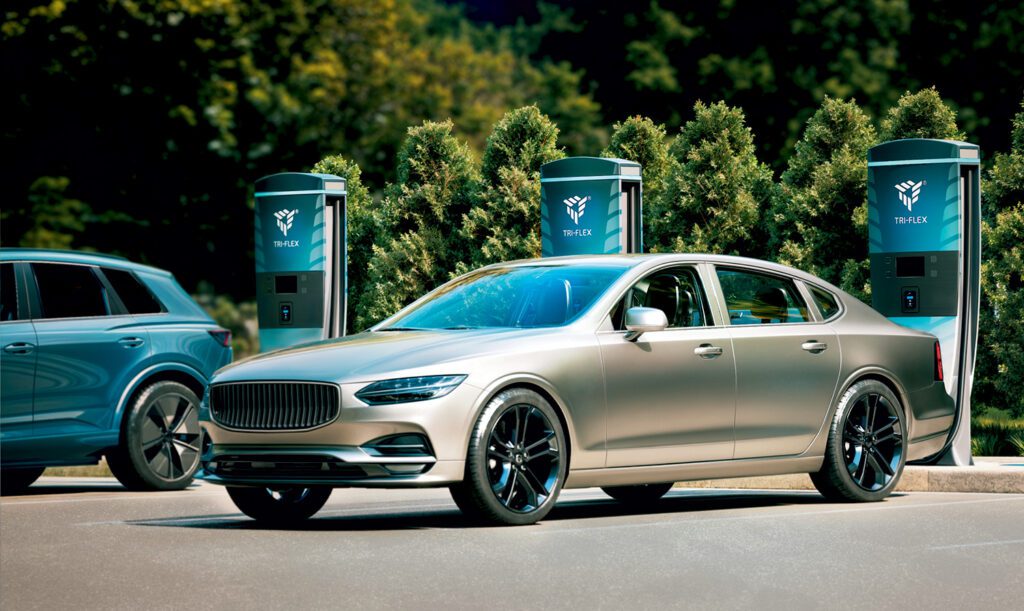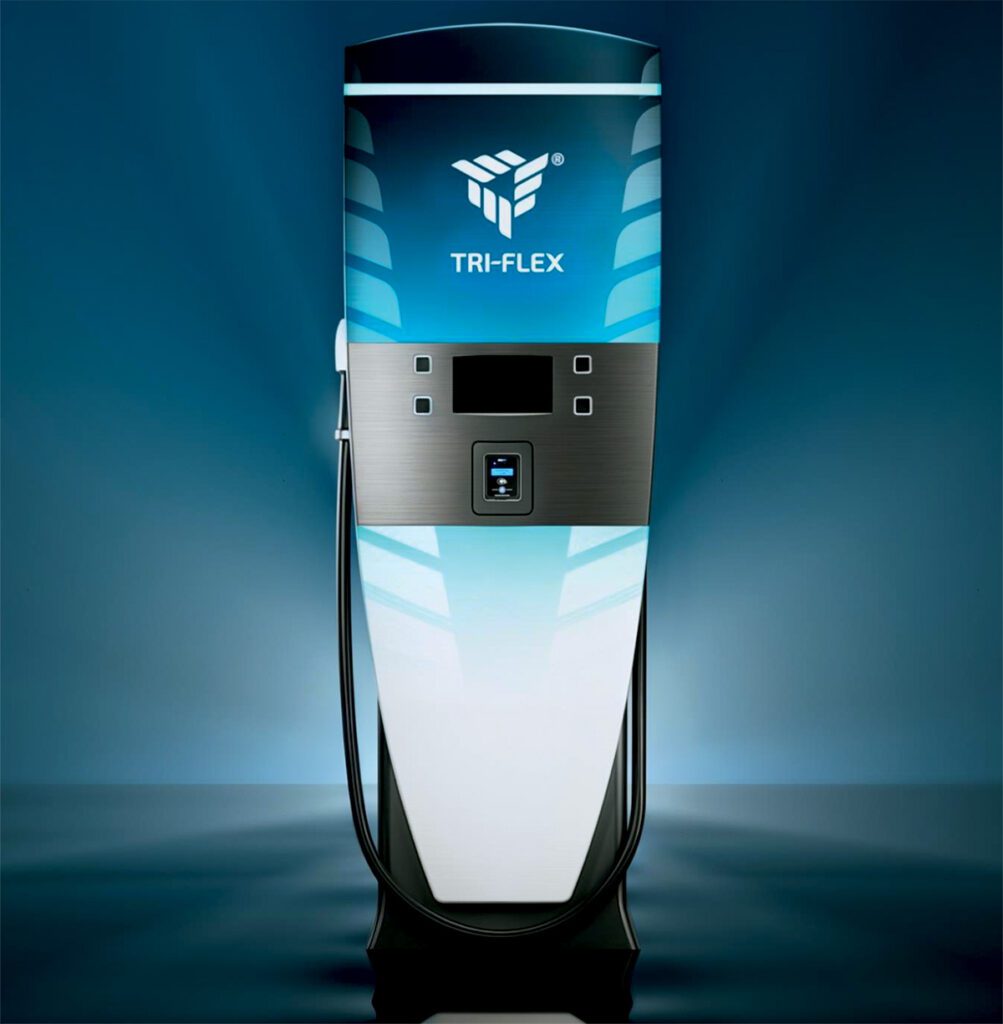
Arcady Sosinov is a veteran of the EV charging industry. In 2014, he founded FreeWire to address the challenges of securing adequate grid infrastructure for DC fast charging sites. FreeWire’s solution, which pairs battery storage with chargers, is one that is now becoming the norm in the industry.
Unfortunately FreeWire, as so many startups have, found itself growing but unable to reach an inflection point in profitability, and when the market cooled, it became insolvent. Sosinov sold the business to a consortium that included Orange EV, a ten-year-old manufacturer of electric terminal tractors, which rebranded FreeWire’s technology as OptiGrid.
Meanwhile, Tritium, which was founded in Australia but quickly grew into a global EVSE supplier, also got financially overextended, went through a reorganization and was bought by the Indian firm Exicom. Tritium, which was a top-three vendor of charging infrastructure in the US, the UK, Europe and Australia, has also made a specialty of integrating its charging solutions with battery storage within DC microgrids, so the Exicom management team brought on Sosinov to rebuild Tritium into a leading global supplier.
Charged spoke with Mr. Sosinov about charging standards, reliability, payment methods, and most important, how a charging hardware vendor can differentiate itself in order to survive the coming consolidation of the industry.
A ton of money went into the charging industry and you had this fast rise. And ultimately, what happens is you have a steep drop, then you have slow growth back to mean reversion.
Charged: Everybody I talk to says there’s going to be a shakeout in the EV charging industry.
Arcady Sosinov: Any exuberant technology, there’s a common pattern to it. A ton of money went into the charging industry, and you had this fast rise. And ultimately, what happens is you have a steep drop, then you have slow growth back to mean reversion.
Tritium was one of the first big dominoes to fall. We were the second-largest hardware vendor awardee under the NEVI program, behind Tesla. We built a large manufacturing facility in Tennessee, and built up over a hundred million dollars in raw materials inventory to support all the orders that were coming in under the NEVI program. And what happened? NEVI did not pan out, and most of that money never hit the streets.



Charged: How many charger manufacturers are going to be left standing?
Arcady Sosinov: I don’t think the market can sustain more than half a dozen. Alpitronic, Kempower and ABB are likely to be left standing. Tritium’s goal is to be a leader as the shakeout occurs, based on our installed base of over 21,000 chargers, our deep customer relationships and our new product portfolio.
Infrastructure is not a high-margin business—it’s all about scale. We need to sell hundreds or thousands of units to a customer, and we don’t make our money on that upfront sale. In this business, you make most of your money on the 10- to 15-year relationship that you have with the customer—aftersales, service, support, spare parts.
Charged: Chargers all do pretty much the same thing. How do you differentiate your product?
Arcady Sosinov: I think there’s only three ways to differentiate: scalability, reliability and cost.
Scalability—it’s clear that the industry is moving to larger sites. We know this because we have a large presence in Europe and the UK, so we can see two to three years ahead of where the US market is today. You can forget about those sites with two chargers in the back of a parking lot. It’s not good for the consumer, and it’s not a good business to run.
And when you go to these larger sites, you start considering, are you going to scale linearly in cost or are you going to scale logarithmically in cost? For example, the Alpitronic 400 kW charger that many networks are deploying today is a great charger, but it’s an all-in-one, standalone box. That scales linearly in cost—you want to add another charger, you pay for another box and you pay for more grid connection.
How do you develop a system that gets cheaper on a per-unit basis as you put more units down? This is where Tritium has always shone. We focus on distributed charging solutions. Our next-generation product, the TRI-FLEX, takes that to the extreme. We have all our power conversion technology at the cabinet next to the transformer. Then we allow you to add up to 32 dispensers and 64 charging ports on that power cabinet. The best Kempower can do is 12 charging ports. We can do 64. That means your cost per port plummets, and that scalability ends up really driving down costs.
We think our strategy of providing lifetime power module warranties will be copied, but only by those who design and manufacture their own power modules.
Charged: The next item on your list is reliability, but how do I know how reliable a product is until I’ve had it in the field for a year or two?
Arcady Sosinov: Either from past experience or because you’re given a tremendous amount of test data from the supplier. Often that isn’t available because you launch new products. You might have lab reliability data, but lab and field are apples and oranges, and even the best suppliers can launch products that aren’t reliable.
So, what we’ve done is to introduce a lifetime power module warranty. It’s the first of its kind. No one’s ever done that before. It’s saying, “We’re confident—you may not have a history with our products, but we’re going to put the risk on us.”
Compare that to the long tail of the market. There are too many players in the market today that buy a Chinese power supply, put it in a server rack and call it a charger. That is not good for anyone—it brings down the whole industry. Anybody that doesn’t own, design and manufacture their own power modules, they’re not going to survive.
We think our strategy of providing lifetime power module warranties will be copied, but only by those who design and manufacture their own power modules. If you’re buying modules off the shelf from a third party, you can’t offer that kind of warranty. The fly-by-night guys are going to disappear, and we need them to disappear.
And then the last way to differentiate is cost, which is a function of scalability and reliability. If you can be the most scalable product, your costs are going to drop as more dispensers get deployed. And if you can take that operating cost away from the charge point operator and absorb that power module cost over 10 years, their total cost of ownership is going to be so much lower.
Charged: Going back to the reliability issue, people tell me that it’s not usually about hardware failures, but about the interfaces among all the different pieces of the stack—hardware manufacturer, software, charge point operator, site host…
Arcady Sosinov: I think it’s all of the above, but you still have loads of hardware issues in the field, both with us and with other vendors. Hardware does break, modules do fail—some more than others, depending on the supplier—and other parts of the system can fail as well. You probably heard about supplier issues with liquid-cooled charging cables. That was a big issue that impacted networks around the world, including Electrify America in the US.
You do have interface issues. Vehicle OEMs do not always conform to the standard CCS protocol, they all have implemented it a bit differently, so there are communication issues between chargers and vehicles. Communication doesn’t just happen at the beginning of a charging session—there’s constant communication throughout the session, and if that communication is in any way non-standard, that charging session ends. That still happens frequently.
The implementation of credit card readers has been frustrating to the industry, and particularly to drivers. I suspect there is something wrong on the credit card reader side, where for the last 10 years I’ve noticed that a lot of times the transactions just don’t register.
It’s strange because it never happens when you’re at a convenience store or when you buy a bag of chips from a vending machine. That seems to work every time. I can point to two things that are different in EV charging. One, EV chargers tend to be in places with poor cellular connectivity. Two, usually, when you do a transaction on a credit card reader, it’s one transaction at a time. You tap and buy your coffee, then it waits for the next transaction. A charger usually has two ports doing simultaneous charging, so you tap, and that card reader has a transaction that you’ve authorized, but it has to wait until the end of the session to know how much to charge you. At the same time, you can have someone else tap on that card reader to start a second charging session. I suspect that there’s an issue with that on the credit card reader company’s backend, but that’s an opaque part of the process to us.
Charged: Is the credit card reader backend something that’s dominated by a few companies?
Arcady Sosinov: Yes, it’s Nayax, Payter, Apollo, Castles and Ingenico. Those five make up the majority of the market.
Charged: How does the EV charger typically interface with the credit card reader backend?
Arcady Sosinov: There’s two ways that credit cards can be implemented: charger-connected or cloud-connected. In the first model, the charger talks to the credit card reader and passes the data through our backend, then passes it to the credit card reader’s backend. The charger becomes the critical path for that credit card reader to talk to its own systems. If we do that, then we need to become PCI-compliant [i.e. conforming to the Payment Card Industry Data Security Standard (PCI DSS), which is designed to protect cardholder data]. And there’s a risk that something’s broken there—we change our code, they change their code, that API doesn’t work anymore. That was the old world of credit card readers.
The industry has almost entirely moved away from that now, and moved to a cloud-connected model, where we simply allow the credit card reader to connect to our modem—we open a port for it and it communicates to its backend itself, and simply sends us a success or fail message. That’s the way we push all customers to do it today because that eliminates any potential interface issues.
But also, because we’re not in that critical path, if there are issues with these credit card readers, which there still are, we are of no help. You can come to Tritium and say, “But that credit card reader’s installed on your machine.” And I’ll say, “Why that charging session didn’t start or that transaction failed, I cannot tell you.”
The question is whether the state of California is willing to shut down access to public chargers across the state to enforce the credit card reader requirement.
Charged: So, there’s a good and a bad side to doing it that way.
Arcady Sosinov: That’s right.
Charged: Does California now require all public charging sites to have credit card readers?
Arcady Sosinov: Yes, and on top of that, you have to have CTEP compliance. When you go to a gas pump, there’s a tag that certifies that the pump has been checked by the California Division of Measurement Standards (DMS) and that it will output the right amount of gas for you and charge you the right amount of money. The state of California created a program called the California Type Evaluation Program (CTEP), which certifies that each charger is measuring electricity accurately.
Charged: That’s similar to the Eichrecht regulation in Germany.
Arcady Sosinov: Yes. But funny enough, many chargers in California are not CTEP-compliant, notably Tesla. They don’t have credit card readers on their chargers.
Charged: Why don’t they have to have credit card readers if everybody else does?
Arcady Sosinov: They do have to, but the question is whether the state of California is willing to shut down access to public chargers across the state to enforce this regulation. Right now, there are DMS staff in California going around and shutting down chargers that aren’t CTEP-compliant. Online, you can find pictures of chargers with a big yellow tag attached to the handle that says, “You cannot use this charger, we’ve notified the charge point operator.” But if you start doing that to Tesla chargers, you’re shutting down the majority of the network in California.
Charged: Did Tesla make a deal with them, or are they just selectively enforcing the regulation?
Arcady Sosinov: I don’t know about any deal, but it does seem that selective enforcement is happening.
Charged: Is Plug & Charge an alternative to having credit card readers?
Arcady Sosinov: We’re going to have to have both options. Credit card readers are mandated because of accessibility issues, but the readers we use in the US are not great.
In Europe, they don’t have swipes anymore. All of our credit card readers in Europe and the UK are just tap. And that means the credit card reader is sealed. In the US, we have swipe, [which reads the card’s magnetic strip], and we have dip, [which reads the card’s embedded chip]. That’s mandated, we have to have those. But that means that the device is now open to the elements, and we see much higher failure rates on credit card readers in the US.
Plug & Charge is a very active standard in Europe. We have it turned on with dozens of charge point operators. There are actually two versions—there’s ISO 15118, which is the standard, and then there’s Hubject, which is a company that has developed a slightly different version. We work with both.
Charged: Are we lagging behind in Plug & Charge implementation in the US?
Arcady Sosinov: Oh, way behind. The best thing we have in the States is Autocharge, which is actually very rudimentary. EVgo was the first one to use Autocharge. All you’re doing is registering the MAC address of your car with the network’s backend, they link it to an account. But it’s insecure, and it’s sort of a hack. Autocharge has to go away, but the issue is that most vehicles on the road today are not Plug & Charge capable.
I think it would be better for the consumer if the whole world chose the NACS standard, but that’s just not the direction we went.
Charged: Teslas in Europe use CCS, not NACS. Why have we gone the opposite way in the States?
Arcady Sosinov: That’s a great question. They went with CCS in Europe because the regulators forced them to. They said, you will not get public funds if you use a proprietary cable, and Tesla switched over.
Technically speaking, NACS is a more elegant standard than CCS. The head of the charging cable can be much smaller. It’s a cleaner design from an engineering standpoint. You pass AC and DC on the same pins (which, technically speaking, was not allowed under UL). CCS has different pins for AC and DC. The head is big, and there’s more sheathing in the cable. All that was done because of UL standards. Tesla said, “Forget the UL standards. We’re going to do what we want and they can conform to us.”
I think it would be better for the consumer if the whole world chose the NACS standard, but that’s just not the direction we went. In Europe, they had to switch to CCS to get public dollars. And in the US, they have such a large market share with NACS that you might as well just go in that direction.
Charged: It sounds like everything comes back to scale.
Arcady Sosinov: You need scale on the hardware side and on the operations side. The charging network operators are like the airlines—they have to have scale. It’s actually pretty easy to start an airline, but it’s very hard to become a Delta or a United because you need tons of routes, you need your own service and maintenance teams, and you need to be in bed with your hardware suppliers. There are only four global suppliers of planes, and the airlines need to know more about those products than even the hardware manufacturers do.
It’s very akin to operating a charging network. You need to have a deep understanding of the hardware. You have to have an incredible engineering team. You have to have your own O&M (operations and maintenance) and service professionals. The chance of you succeeding as a small player in that kind of industry, it’s slim to none.
Charged: So, when things consolidate and there are a lot fewer charge point operators, will that make your job easier?
Arcady Sosinov: Ideally, yes. And those charge point operators won’t deal with only one hardware vendor, just as any major airline will buy both Boeing and Airbus. That’s where this industry has to go. Those of us that know that want it to go there faster.
This article first appeared in Issue 73: July-September 2025 – Subscribe now.
from Charged EVs https://ift.tt/gCreQl9


No comments:
Post a Comment